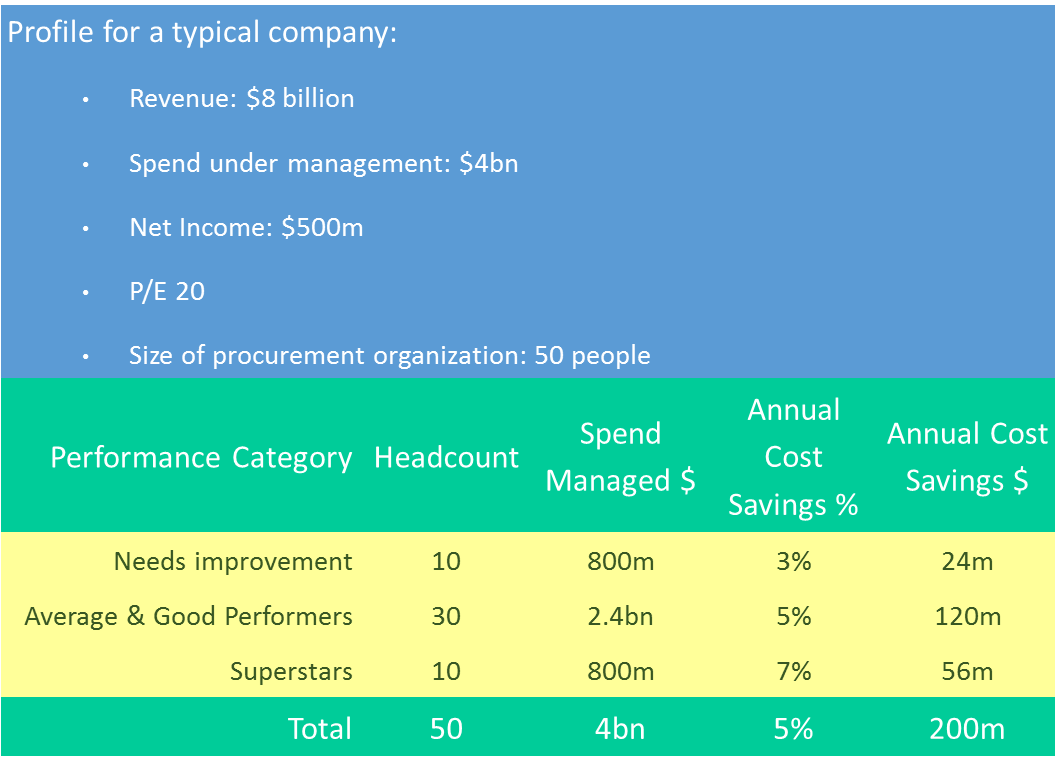Capturing productivity gains in procurement at the company level to boost top and bottom lines
Increase your procurement team’s productivity: We discuss how CPO’s can boost procurement productivity by utilizing todays advanced procurement talent analytics
1. Increase your procurement team’s productivity
A universal problem
CPO’s know that talent management is strategic (Figure 1), but sooner or later, every CPO faces a similar people problem:
- You know that the skillful management of your teams skills can make a significant difference in their productivity—and in your company’s earnings.
- Yet faced with either, fragmented, or no hard data to support deployment decisions, most companies abandon the attempt to make rational choices and instead rely on gut feeling when assigning team members to work or project initiatives.

CPP Talent Management in the CPO’s Positioning Matrix
Team members typically possess diverse skills and by treating them as an undifferentiated resource, managers lose the opportunity to make significant gains in productivity, profitability, employee engagement and personal development.
Furthermore, deploying talent more effectively is only the start. To optimize the productivity of their teams managers must:
- Anticipate the company’s workforce requirements
- Provide training tailored to individual goals
- Reward employees for their achievement.
It is, therefore, no surprise that a systematic and continuous approach to placing the right person in the right job has long been the Holy Grail for most CPO’s, managers and HR professionals, who frequently come up empty-handed.
Today’s data analytics makes it is increasingly possible to deploy a more sophisticated approach to the management of a large distributed workforce. Analytics makes it possible to embed skills assessment, increased engagement and collaboration, with employees to map organization wide capabilities efficiently and cost-effectively, integrating:
- Recruitment
- Training & Development
- Recognition
- Succession-planning
- Collective competence development
In the knowledge economy, labor, next to external purchases represents the largest expense, and talent, is the critical resource. The presence of a skills gap or deploying talent ineffectively will cost money and lost opportunities for growth.
1.1 CPO’s require data-driven insight:
Specifically, they need to identify:
- Their critical competencies
- The critical roles and individuals
- How workforce problems affect the company’s business performance
Armed with this information CPO’s can put in place plans to develop the collective competence of their team to boost procurements productivity.
2. The challenge of organizing the workforce
Value increasingly comes from increasing the productivity of individuals and from greater workforce innovation. This requires aligning the structure, with culture, capabilities and collective knowledge to drive collective competence (Figure 2):

Fig 2: Collective Competency in the Procurement Organization
When combined with a winning strategy, the organization is poised for success:
- Successful organizations are nimble and focused
- Getting the right people in the right positions drives strategy
- Change management capabilities increase the odds that a transformation will stick and succeed
- A high-performance culture aligns and engages employees
Starting before people are hired managers can systematically scan the employee life cycle to uncover the productivity barriers that a company and its employees face. To know what kind of candidates to hire, how many, and when, for instance, managers should turn to workforce forecasting:
- Break down skill requirements and retention rates by position
- Develop a clear recruitment and training and development program
- Deployment, to the appropriate role
- Develop incentives and continual development opportunities
- Succession planning
Success can provide a lasting source of competitive advantage.
3. Making the Talent link to Business Performance?
Linking workforce needs with the company’s financial performance is a key driver for action:
To demonstrate the concept we can take a typical company and use a simple metric such as cost savings. Keeping in mind that numbers will vary by industry, the concept is valid across industries.
The first step is to gain the visibility of current performance for your organization by identifying the superstars and the low performers and to develop a plan to raise the overall level of performance. In our example (Figure 3) management has identified:
- 10 people are superstars
- 30 are average to good performers and
- 10 need improvement.
The superstars deliver 7% cost savings, average performers 5%, and low performers deliver 3%.
From the chart, you can see:
- Superstars delivered $32 million more in savings than the low performers
- By raising the performance of the low performers to that of the superstars increases savings by 16% ($32m/$200m).
- In addition to increasing the performance of the low performers, you should be able to increase the performance of the entire team, by changing the perception of what average is.
Organizations that can remove the barriers to hiring more knowledgeable staff, with the right mindset, and business acumen, for example, can reduce their cost, and increase revenue—but which barriers should go, and at what cost?
Without a link between workforce planning and financial performance companies are flying blind. CPO’s must identify the barriers to higher productivity and to model their cost, to identify the bottom-line impact of higher workforce productivity.
4. Increase your procurement team’s productivity
The Procurement Talent Imperative
The gains that come from workforce innovation and more sophisticated people management are the key to procurement productivity and value creation.
Many organizations still use primitive and fragmented tools that have reached the limit of their usefulness.
CPP’s iProcure platform brings the data together where you need it. On your desktop. It enables managers to make the connection with the core financial, human resource, and operational goals that guide decision making.
Using its potential for employee engagement and collaboration enables organizations to shift their focus from the individualist view, towards a collectivist view focused on the development of collective competence to build increased overall performance and productivity.
Nuff said …
You can read more here or contact us for more information.
Learn more: Procurement Skills Assessments



